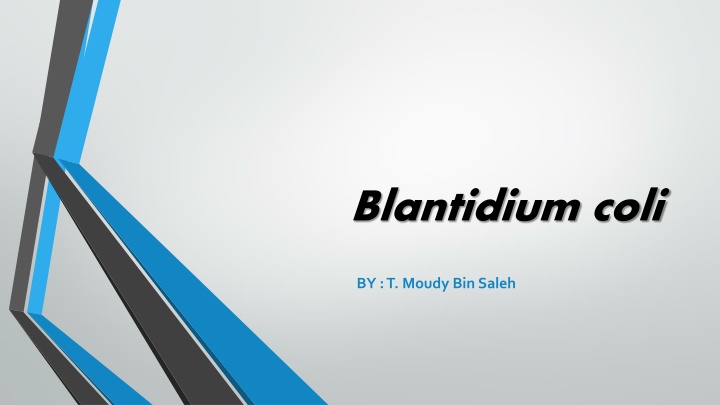
Balantidium coli: A Parasitic Ciliate Alveolate
Explore the characteristics, life cycle, transmission, geographic distribution, clinical presentation, and stages of Balantidium coli. Learn about Balantidiasis, a zoonotic disease acquired through the feco-oral route, primarily from pigs. Discover the significance of trophozoites and cysts in the diagnosis of this parasitic infection.
Download Presentation

Please find below an Image/Link to download the presentation.
The content on the website is provided AS IS for your information and personal use only. It may not be sold, licensed, or shared on other websites without obtaining consent from the author. If you encounter any issues during the download, it is possible that the publisher has removed the file from their server.
You are allowed to download the files provided on this website for personal or commercial use, subject to the condition that they are used lawfully. All files are the property of their respective owners.
The content on the website is provided AS IS for your information and personal use only. It may not be sold, licensed, or shared on other websites without obtaining consent from the author.
E N D
Presentation Transcript
Blantidium coli BY : T. Moudy Bin Saleh
- Blantidium coli is aparasitic speciesofciliatealveolatesthat causes the diseaseBalantidiasis. -It is the only member of the ciliate phylum known to bepathogenicto humans.
Scientific classification Phylum: Ciliophora Class: Litostomatea Order: Vestibuliferida Family: Balantiididae Genus: Balantidium Species: B. coli
Balantidiasis is a zoonotic disease and it is acquired by humans via the feco-oral route from the normal host, the pig, where it is asymptomatic. Contaminated water is the most common mechanism of transmission.
Geographic Distribution Worldwide. Because pigs are an animal reservoir, human infections occur more frequently in areas where pigs are raised. Other potential animal reservoirs include rodents and nonhuman primates. Clinical Presentation Most cases are asymptomatic. Clinical manifestations, when present, include persistent diarrhea, occasionally dysentery, abdominal pain, and weight loss. Symptoms can be severe in debilitated persons.
Stages Both Balantidium coli trophozoites and cysts are found in stool and they are yellowish or greenish in color. Trophozoites are characterized by: their large size (40 m to 200 m), the presence of cilia on the cell surface, a cytostome, and a bean shaped macronucleus which is often visible . Cysts are smaller than trophozoites and are round and have a tough, heavy cyst wall made of one or two layers. Usually only the macronucleus and sometimes cilia and contractile vacuoles are visible in the cyst.
B A Figure A : B. coli cyst in a wet mount, unstained. Figure B : B. coli trophozoite in a wet mount, 500 magnification. Note the visible cilia on the cell surface.
C D Figure C:B. coli trophozoite in a Mann's hematoxylin stained smear, 500 magnification. Note the bean shaped macronucleus. Figure D: Balantidium colitrophozoites in intestinal tissue, stained with hematoxylin and eosin (H&E)
